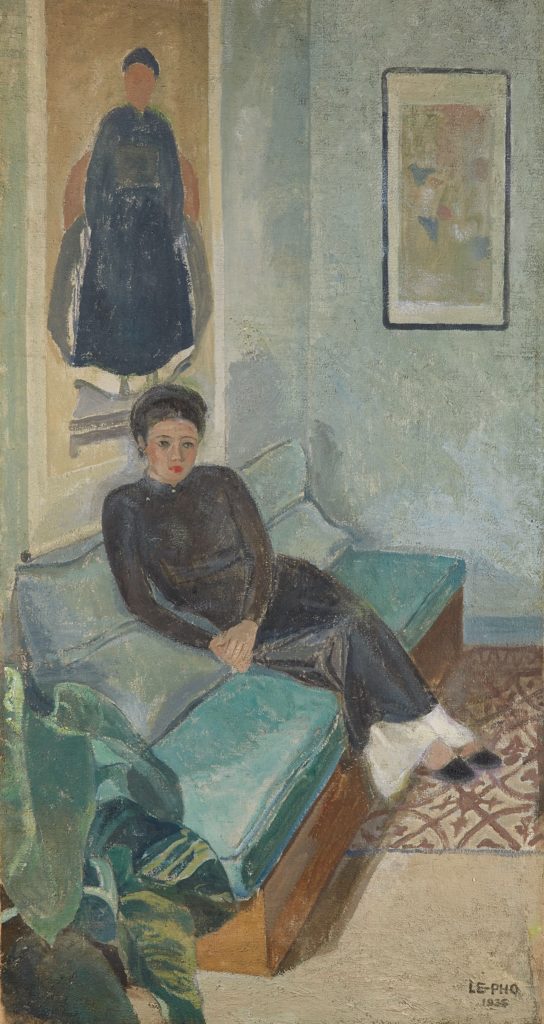Le Pho: “Portrait of Le Thi Luu”, 1935, or “the half-open door lets in the breeze”
Large works in oil on canvas from Le Pho’s early period are extremely rare. They include “L’Âge heureux” (1930), illustrated in Trois Écoles d’art de l’Indochine (1931) and in Art of Vietnam by J.F. Hubert and C. Noppe (2002), “La maison familiale au Tonkin” (1929) exhibited in La Maison de l’Asie du Sud-Est at the Cité internationale Universitaire de Paris, “La vue du haut de la colline” (View of the hilltop) from the Tholance-Lorenzi Collection and “Nue” (nue) from the Tuan Pham Collection among others.
Our painting is a rare portrait of 24-year-old Le Thi Luu, who was not only a talented painter, but also the friend and muse of the first generation of modern Vietnamese painters of the 20th century – Le Pho, Mai Trung Thu, Nguyen Phan Chanh, Vu Cao Dam, To Ngoc Van, Tran Quang Tran, Nguyen Cat Tuong, Pham Hau, Nguyen Gia Tri and others.
The work is structured with clear, distinct lines, mainly vertical and oblique, but also cold, bluish tones that challenge the geometric treatment of the pictorial space, as if the colour were disputing the line.

The painting does not aim to be a profound manifesto, but it remains one of the most pertinent illustrations of Le Pho’s (and Le Thi Luu’s…) social milieu in Vietnam in 1935.
The beautiful artist is dressed in the ao dai revived by Nguyen Cat Tuong (Lémur), her classmate at the Hanoi School of Fine Arts (he graduated a year later in 1933). However, her shoes and headdress remain in the classic Tonkinese style. Le Thi Luu seems to be the literal and figurative descendant of the classic “ancestor portrait” hanging on the wall above the bench and its long cushion against which she leans, elegant, reserved but attentive.
Another painting remains “illegible” (a contemporary work?) in the background on the right, while the plant, a graphic quotation that Le Pho was fond of using in the 1930s, on the lower left alludes to the wear and tear of time. The volutes of the plant, like the patterns on the carpet, challenge the strict geometric order of the painting.
But above all, this face, with its discreet make-up (apart from the scarlet lipstick), expresses not only a certain sadness, but also a determination that was to characterise Le Thi Luu’s entire life.
With its series of clear oppositions, our painting crystallises many of the current issues that came to the fore in 1935 in a Vietnam faced with a dilemma between modernisation and tradition, renewal or decline, nationalism or universality, passivity or activism, individualism or conformism.
In France, the Front Populaire will win the 1936 elections and the political message will be socialism: in Vietnam, the colonial power proposed a new discourse in which social dialogue became the necessary paradigm.
Signifying and committing…
The following year, Victor Tardieu, founder of the Indochina School of Fine Arts in Hanoi, died. With him died the spirit of a quasi-family project. The Pho moved to Paris. Le Thi Luu and her husband left for France in 1940. Vu Cao Dam had lived there since 1931, Mai Thu since 1937.
In our still misogynistic world, we often forget that the “trio” was a quartet.
Inseparable in France until the death of Mai Thu in 1980 and Le Thi Luu herself in 1988.
As Phan Chau Trinh (1872-1926) wrote in his poem La Chandelle:
But the half-open door lets in the breeze
In the night that is drawing to a close, to whom can you entrust your tears?
Jean-François Hubert